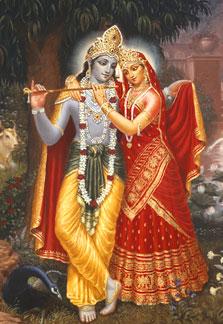Radha Madhava Kalyanam

Kotnotsavam:
In Telugu Sampradayam, paddy (rice covered with a light skin) is poured into a wooden Stand with hollow side on top and a round flat base) and it is crushed with ULAKKAI (a long round shaped thick stick) decorated with Mango Leaves, red and white colour lines, flower etc. The powder coming out of this crushing is taken and poured into the cloth around the couples' waiste and later they are taken for Oil both, to be brushed with this powder. Then they are offered dresses by the Priest which they wear in the marriage. As the Padhathi is given by Telugu Gurus, they have prescribed the same method. Here we assume that Muthu, Vairam, Vaidooryam etc. are poured into the Ural (now-a-days represented by Akshathai – rice mixed in Haldi) and crushed with Ulakkai to make it a fine powder which is poured imaginarily into the cloth around the waiste of the couple and later they are bathed with fragrant oil (known as Thanadu Shobanai) and offered dresses. This is called Muthukkuthal and Thalandu Shobhanai. These are performed with special songs, describing them.
Here, one should look into the spiritual import. The Ural is compared with our Pure Mind, the Ulakkai with Omakara Naadam and the Akshathai with us as Jeevaatmaan – the Satwic natured Jeeva (white coloured rice) encompassed by Maaya (the skin covering the rice). For realization of God, we need to keep our mind pure, free from the Kama Krodhaadhi Shatgunas, away from Thripudi etc. into which pour ourselves – the jeevaatmaas (in meditation).
For meditation, as the mind needs the co-operation of the Panchendriyas (which bring the stimuli from outside into our mind) five Kanyakas (girls below the age of 11 years, who are considered to be free from Kalmasham (evil thoughts)) representing the Five Sense Organs are made to pour these Akshathai (Jeevatma) into the Ural (Mind), and five Bhagavathaas (representing the five matured Karmendriyas) repeatedly hit the rice in the Ural with the Ulakkai (Omkara Naadam,) to the tune of songs describing the qualities of the Lord.(known as Muthukkuthal) and remove the covering (Maaya) - known as Muthukkozhithal - and bring out the white coloured akshathai (Jeevatma) and pour it uno the roshtrum of the Lord. This is the symbolization of Jeevatma, released from Maaya and having become pure, merges into the Brahman.
The entire process of Muthukkuthal and Muthukkozhithal (Kotnotsavam) represents the process of meditation, which is done with the co-operation of Five Sense Organs and Five Karmendriyas and chanting inside the Omkara Naadam as described above. Thus, this is a process of realization of God through meditation. If we have this mindset while performing the Kalyanam, that is more than enough. We will be blessed with Lord;s grace. To commemorate the Jeeva Brahma Ikyam as above, whereby the Bhaktha becomes Jeevan Muktha. Harathi is taken
There are two opinions about Kotnotsavam. Some say that it is to be done only in Seetha Kalyanam, Rukmini Kalyanam, Venkateswara Kalyanam etc. and it is not required in Radha Kalyanam. Another set of people opine that it is required in Radha Kalyanam also. Any way, as these Kalyana Padhathis are in Telugu Sampradaya, Muthukuthal is prevalent in Karnataka and it is being performed. There is nothing wrong to perform it, since it has a spiritual meaning in it.
Musala Narthanam:
Bhagawathas dance with joy with the Ulakkai on hand to the tune of the Ashtapathi song. This depicts the joy of Jeevan Muktha, who dances in joy as he stays at this state for ever. Also, once the Jeevaatma merges with Paramatma, there is no question of Dwandhwa Bhava and hence Omkaram does not exist separately. The Brahman, Omkara and Jeeva all are one now. Hereafter the Jeevan Muktha ever shines joyous in the Blissful status.
- All the parts of this article are contributed by Achala Bhakthan .